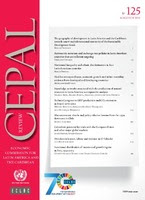By Esteban Pérez CaldenteyRaúl Prebish’s Unpublished Manuscripts on the Buenos Aires Lectures on Economic Dynamics edited by Esteban Pérez Caldentey (ECLAC) and Matías Vernengo (Bucknell University), have been published in the ECLAC Review, August 2018 Raúl Prebisch (1901–1986), the Second Executive Secretary of the Economic Commission for Latin America and the Caribbean (ECLAC) which he joined in 1949 is mostly known for his long-run analysis and diagnostic of the development problem of Latin America, which he fully stated in “The economic development of Latin America and some of its principal problems” (1950), also known as Prebisch’s “Manifesto”.However, prior to joining ECLAC Prebisch also devoted a great part of his time and career the analysis of business cycles in theory and in
Topics:
Matias Vernengo considers the following as important: Esteban Pérez, Prebisch
This could be interesting, too:
Matias Vernengo writes Esteban Pérez Caldentey on the Ideas of Raúl Prebisch
Matias Vernengo writes Dollar Hegemony and Argentina
Matias Vernengo writes Dollar Hegemony, coming soon
Matias Vernengo writes How Industrialization Become the Core of Raúl Prebisch’s Thought
By Esteban Pérez Caldentey
Raúl Prebish’s Unpublished Manuscripts on the Buenos Aires Lectures on Economic Dynamics edited by Esteban Pérez Caldentey (ECLAC) and Matías Vernengo (Bucknell University), have been published in the ECLAC Review, August 2018
Raúl Prebisch (1901–1986), the Second Executive Secretary of the Economic Commission for Latin America and the Caribbean (ECLAC) which he joined in 1949 is mostly known for his long-run analysis and diagnostic of the development problem of Latin America, which he fully stated in “The economic development of Latin America and some of its principal problems” (1950), also known as Prebisch’s “Manifesto”.
However, prior to joining ECLAC Prebisch also devoted a great part of his time and career the analysis of business cycles in theory and in practice (he was the first Director General of the central bank of Argentina created in 1935 and Prebisch himself drafted the project for the bank). On the basis of his cycle analysis he began to develop a theory of dynamics which sought to introduce two elements that, according to Prebisch, were missing from the Classical and Keynesian analyses, time and space.
Prebisch argued that capitalist economies evolved and developed in growth cycles. From 1920 to 1944 his analyses of capitalism centered on Argentina and on the characteristics of its business cycle. He attributed the phases of the Argentinean cycle to external causes determined to a large extent by the policy and economic performance in developed countries (Great Britain and the United States).

